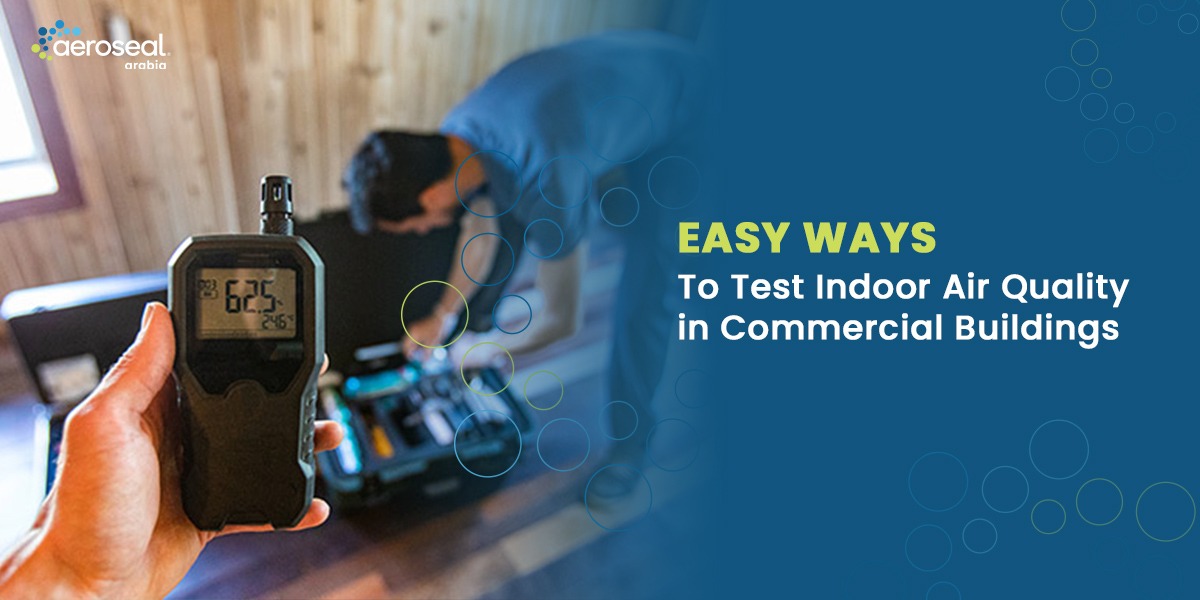
Easy Ways to Test Indoor Air Quality in Commercial Buildings
Indoor air quality (IAQ) plays a critical role in maintaining safe, healthy, and productive commercial spaces in Saudi Arabia. With the Kingdom’s hot climate and heavy reliance on air conditioning, many businesses overlook how pollutants can circulate indoors. Poor IAQ not only reduces comfort but can also harm employee health, increase absenteeism, and damage company reputation. For building owners, facility managers, and employers, testing and maintaining air quality is no longer optional it’s a responsibility.
Why Indoor Air Quality Matters in Saudi Arabia
Commercial buildings in Saudi Arabia, such as offices, shopping malls, hospitals, and schools, are enclosed environments where people spend long hours daily. Unlike outdoor spaces where pollutants disperse, indoor environments trap dust, chemicals, and gases. The Ministry of Health highlights that poor IAQ is linked to respiratory issues, headaches, fatigue, and worsening asthma.
In cities like Riyadh, Jeddah, and Dammam, high levels of outdoor dust and sandstorms often contribute to indoor contamination. Add in the chemicals from cleaning products, emissions from office equipment, and humidity challenges in coastal areas, and the risks become even higher. Testing IAQ ensures compliance with Saudi building standards, protects occupants, and improves overall workplace well-being.
Common Pollutants Found in Commercial Spaces
Before testing begins, it helps to know the typical threats to IAQ in Saudi buildings:
- Particulate Matter (PM): Dust, pollen, and tiny particles that affect lungs and trigger allergies.
- Volatile Organic Compounds (VOCs): Emitted from paints, furniture, and cleaning agents, causing eye and throat irritation.
- Carbon Monoxide (CO): A dangerous gas from fuel-burning equipment that can lead to poisoning.
- Radon: A naturally occurring radioactive gas that can accumulate indoors, linked to lung cancer.
- Mold and Mildew: Caused by moisture or poor ventilation, especially in coastal cities with higher humidity.
- High Carbon Dioxide (CO2): From poor ventilation, leading to fatigue, lack of focus, and reduced productivity.
Knowing these pollutants allows managers to choose the right testing methods.
1. Use Commercial Air Quality Monitors
Installing professional air quality monitors is one of the easiest and most effective ways to test IAQ in commercial buildings. These devices measure particulate matter, VOCs, CO2, and humidity in real time. Many modern systems can be integrated with building management software, giving facility managers dashboards that display pollutant levels across different zones.
In Saudi Arabia, where energy efficiency is also a government priority under the Saudi Green Building Code, smart monitors help balance air safety with energy savings. By identifying problem areas quickly, businesses can respond before issues escalate.
2. Schedule Regular HVAC Inspections
Heating, ventilation, and air conditioning systems are at the heart of IAQ in Saudi commercial buildings. Since these systems run almost year-round due to extreme heat, filters clog quickly with dust and sand. Leaks in air ducts also allow pollutants to spread across entire floors.
Regular inspections by certified HVAC professionals ensure filters are replaced on time and ducts remain sealed. According to the Saudi Standards, Metrology and Quality Organization (SASO), routine HVAC maintenance reduces energy waste and keeps indoor air within acceptable quality levels. Facility managers should schedule inspections at least twice a year.
3. Conduct Radon and Gas Testing
Radon may not be as visible a threat as dust or mold, but it is one of the most dangerous. Commercial buildings should undergo regular radon testing, especially in areas with naturally high levels of underground gas. Simple detection kits are available, but hiring professionals ensures more accurate readings.
Carbon monoxide detectors are also a must in commercial spaces with fuel-burning appliances, generators, or parking structures. These devices provide life-saving alerts in case of leaks, protecting staff and visitors. In line with international occupational safety standards, many Saudi businesses are adopting continuous monitoring systems for both radon and CO.
4. Check for Mold and Moisture
Mold can grow quickly in damp areas such as storage rooms, basements, and bathrooms. In Jeddah or Dammam, where humidity is naturally higher, mold problems are especially common. Testing involves air sampling, surface swabs, and thermal imaging to detect hidden growth.
If left untreated, mold can trigger asthma attacks, allergic reactions, and serious respiratory illnesses. For commercial buildings, visible mold or odor complaints can also damage reputation. Hiring certified IAQ professionals to perform mold assessments helps prevent costly repairs and ensures compliance with workplace safety laws.
5. Perform CO2 Testing for Ventilation
High carbon dioxide levels indicate poor ventilation. In crowded offices or meeting halls, CO2 can build up quickly, leading to tiredness, headaches, and poor concentration. CO2 testing devices provide accurate readings and help managers decide whether ventilation systems need upgrades.
For example, smart buildings in Riyadh use automated systems that increase fresh air supply when CO2 levels rise. This not only improves worker comfort but also boosts productivity, which is crucial for businesses aiming for high performance.
6. Hire Professional Air Quality Services
While DIY kits can provide a general idea, professional IAQ services are the most reliable way to test commercial buildings. Certified experts use advanced tools to measure pollutants, identify problem sources, and provide tailored recommendations.
Professionals may suggest solutions such as duct sealing, installing HEPA-grade purifiers, or upgrading to energy-efficient HVAC systems. In Saudi Arabia, partnering with licensed providers also ensures compliance with local building and health codes, avoiding penalties during inspections.
Improving Indoor Air Quality After Testing
Testing is only the first step. Once results are available, managers should act on recommendations immediately. Common improvements include:
- Installing commercial-grade air purifiers with HEPA and activated carbon filters.
- Improving ventilation to increase fresh air circulation.
- Scheduling routine maintenance for HVAC and duct systems.
- Controlling indoor humidity with dehumidifiers in coastal cities.
- Using low-VOC cleaning products and furniture.
By combining testing with preventive measures, businesses can create healthier environments for employees and customers.
When Should You Test IAQ in Commercial Buildings?
Regular IAQ testing is recommended at least once a year. However, additional testing may be necessary in the following cases:
- After building renovations or new construction.
- When unusual odors or visible mold appear.
- If employees complain about headaches, allergies, or fatigue.
- After installing new carpets, furniture, or painting.
- Following sandstorms or extreme weather events that increase dust.
Proactive testing helps prevent small issues from becoming major health and compliance problems.
Conclusion
Maintaining indoor air quality in Saudi Arabia’s commercial buildings is vital for health, safety, and productivity. With rising standards set by SASO and growing awareness from the Saudi Green Initiative, businesses must take IAQ seriously. From installing monitors to hiring professionals, there are many effective ways to test and improve air quality.
For building owners and facility managers, investing in regular IAQ testing not only protects occupants but also strengthens trust, reduces risks, and ensures long-term sustainability. Clean air is not a luxury it is an essential part of running a successful business in the Kingdom.



